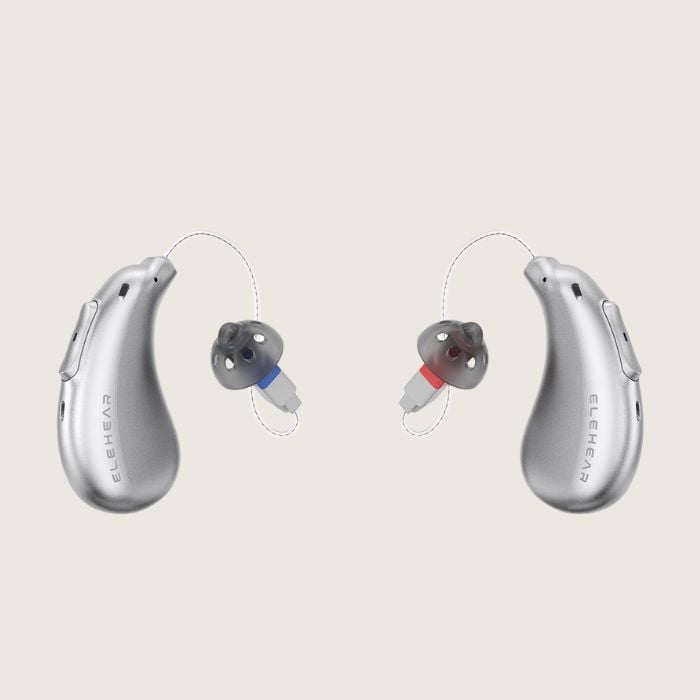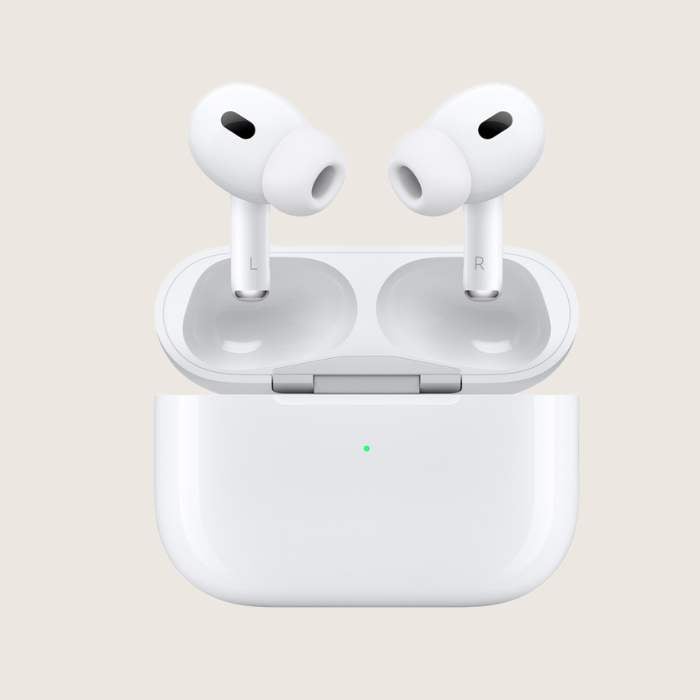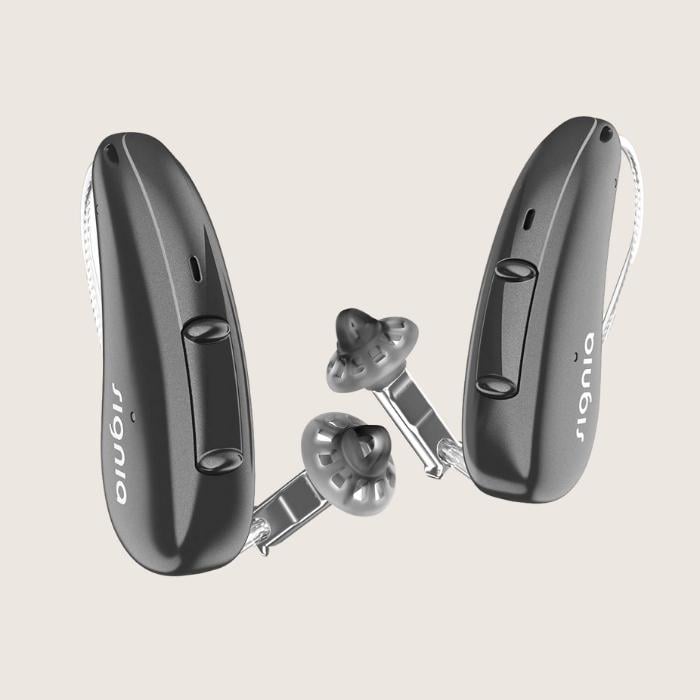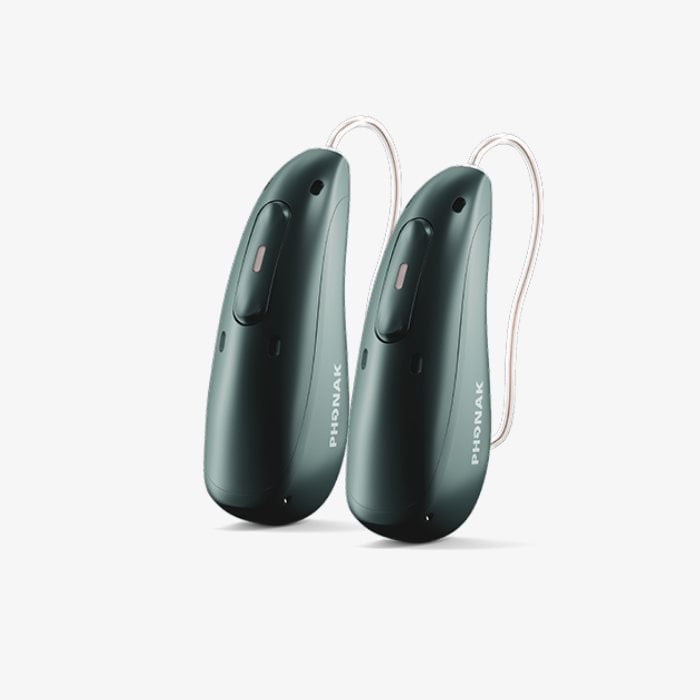Soundly’s team of hearing aid wearers and audiologists has helped thousands of people find the right hearing aids over the past year—many of them seniors.
In this guide, we’ll share our top tips for shoppers, highlight insights from our product reviews, and help you choose the best hearing aid for your budget and needs
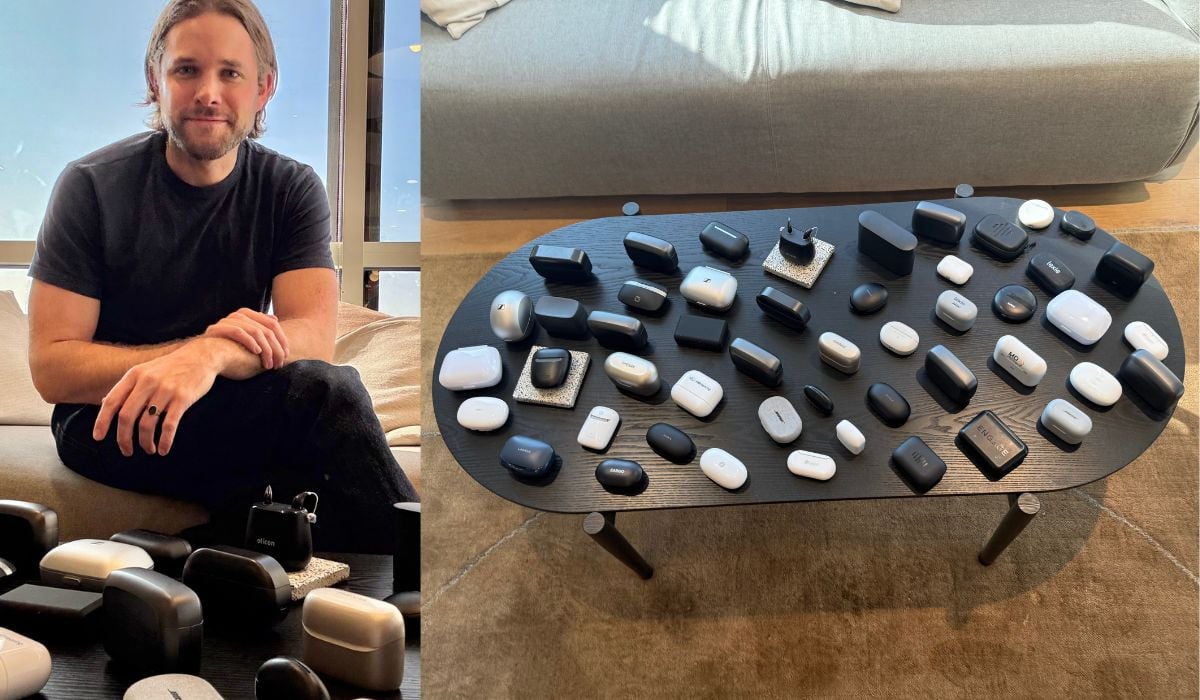
Hearing loss is common among older adults, with nearly one in three people over 65 experiencing some degree of difficulty. It’s a natural part of aging, and if you’re shopping for hearing aids, you’re in good company.
When selecting hearing aids for seniors, we’re focused on a few key factors:
- Trusted brands. It’s important to choose products from established brands known for quality and reliability.
- Simple setup. We prioritize hearing aids that are easy to handle and don’t require constant adjustments or extensive technical know-how to get the sound just right.
- Robust support. Products that offer access to real-time help—whether through live human support or face-to-face consultations with a doctor—can make all the difference.
- Affordable options with predictable pricing. Budgets vary widely among seniors, so we’ve included both highly affordable products and premium options with clear, predictable price structures.
- Ease of handling. For those with limited dexterity, we look for rechargeable hearing aids that are simple to remove from their case and insert into the ear.
- Excellent sound quality and performance. Regardless of age, hearing aids should improve clarity, reduce background noise, and enhance speech so users can feel more confident and engaged.
Below, we’ll dive straight into our top hearing aid picks for seniors. If you’re just getting started, keep scrolling for our step-by-step shopping guide, where we’ll cover everything from understanding your hearing test to insurance coverage, hearing aid styles, and more.
- 50+ hearing aid brands reviewed and rated by our team of hearing aid wearers and audiologists
- 200+ hours each month spent researching brands and care options
- 2,000,000 people shopped on Soundly in 2024
- 100% independently owned and operated
Read more about our company, services and process here.
Featured in this article
Best Affordable Hearing Aids for Seniors
If you’re looking for an affordable starting point, over-the-counter (OTC) hearing aids might be the way to go. OTC hearing aids are designed for those with mild to moderate hearing loss, rather than severe to profound, and typically cost between $500 and $1,000, depending on the brand. That’s a significantly less than to the national average of around $4,500 for prescription devices.
It’s worth noting that OTC hearing aids often require some level of tech-savvy—either from the user or a caregiver—to set up and maintain. That said, a few standout brands make affordability and ease of use their priority. Here are three top picks:
- Sennheiser All Day Clear – Known for its simple setup and comfortable all-day wear.
- Elehear Beyond – Offers a straightforward setup and one of the most affordable price points in the category.
- Apple AirPods Pro 2 – Great hybrid product and easy integration with Apple phones (not best for all-day wear).
If you haven’t tested your hearing yet, you can take Soundly’s free test here using any decent pair of headphones.
Sennheiser All Day Clear
- Our favorite OTC hearing aids for under $1,000
- Manufactured by the largest hearing aid maker in the world
- Compatible with iPhone and Android devices
Sennheiser All Day Clear is our top-selling and best-rated OTC hearing aid at Soundly.com. We’ve tested this product extensively—in the audiology test box, in real-world noisy environments, and through thousands of Soundly customer experiences in 2025.
Soundly offers a complimentary setup call with every purchase — a helpful perk for customers and a valuable way for us to hear firsthand which products are performing best.
At-Home Delivery

Sennheiser All Day Clear is made by Sonova, the world’s leading hearing aid manufacturer. Unlike traditional in-clinic devices that average around $5,000 a pair, All Day Clear ships directly to your home (Soundly offers free 2-day shipping) and lists for $999 per pair.
Rechargeable with Bluetooth
These hearing aids deliver 18–20 hours of battery life on a single charge and offer reliable call and music streaming for both iPhone and Android users. Thanks to Sonova’s Bluetooth Classic connection, pairing is easier than most OTC devices—especially for Android users.
App Programming

As a self-fitting product, All Day Clear uses a smartphone app to adjust the hearing aids to your specific hearing loss. The app isn’t the most feature-rich on the market, but in our testing (and from what we hear from customers), it’s the easiest to set up and navigate.
Sound Quality
Likely your biggest question: how do they sound? In short—excellent. You can hear Sonova’s signature processing in these devices. They handle sudden sounds, wind, feedback, and background noise in a way we’d consider market-leading for OTC self-fitting hearing aids.
Notes & Watchouts
- Best suited for mild-to-moderate hearing loss. If your loss is more significant or complex, in-clinic care is still the right move. Take our hearing test to better understand your loss.
- The charger must be plugged into the wall while in use. A separate power pack is available if you want mobile charging.
Bottom line: Sennheiser All Day Clear sits at the top of our list for self-fitting OTC hearing aids. It delivers great sound, simple control, and strong value from a world-class manufacturer.
You can purchase Sennheiser All Day Clear hearing aids directly through Soundly for $999 per pair and access all of our care and services.
We recommend taking our hearing test before purchasing. Our team can review your results and offer a second opinion if needed.
Once you’re ready, you can place your order on the website or over the phone.
- Sennheiser orders come with 100-day risk-free returns — exclusively on Soundly.
- Your hearing aids ship 2nd Day Air to your home.
- Upon arrival, you’ll receive setup instructions and use the smartphone app to customize your hearing aids.
- Sennheiser includes starter domes in the box; you can purchase alternate sizes and styles through Soundly.
- Every order includes a complimentary setup session with one of our hearing professionals.
- We offer MSRP pricing and deals and will price-match any other official retailer offering the same product and terms.
- Soundly provides 45-day price-drop protection—if the price drops within 45 days, contact us and we’ll refund the difference.
Here's what Dr. Amy Sarow, Audiology Lead at Soundly, had to say about the Sennheiser All Day Clear:
What is your experience supporting customers directly with this product. What comes up a lot?
Customers often ask about how to adjust their devices to match or closely align with their audiogram. While OTC devices use ‘presets’ - if they have a mild to moderate high frequency loss, we can usually come close to what is appropriate for their needs.
The Sound Profile uses three categories during the setup: volume, clarity, and balance. We generally perceive volume in the low frequencies, most people have normal hearing to mild hearing loss in that region, so the preset default of 3 is usually fine.
The clarity setting is the amount of high frequency amplification. The default here is also 3, which is appropriate for a mild loss and for a moderate loss a high number is more appropriate (i.e., a 5 or 6). The balance setting allows the user to adjust volume for right and left separately.
Customers often ask how to keep the adjustments when they ‘split’ the volume on the main app screen, but this setting will revert back to the middle after the hearing aids are placed in the charger and taken out again the next day.
Compared with other hearing aids at a similar price, where does Sennheiser All Day Clear stand out, and where does it fall short?
Compared to other products at the same price point, Sennheiser All Day Clear shares the processing of its prescription counterparts (Unitron and Phonak).
The sound processing feels smoother and more sophisticated than some other options in this pricepoint or lower.
The ADC also does an excellent job of feedback suppression, with some other similar OTC products more prone to feedback in the ear.
However, the ADC app falls a bit short compared to some of the other OTC apps. For example, no direct controls in the app for background noise suppression, ability to directly select hearing aid programs.
The app feels a bit more simplistic than some comparable OTC brand apps.
Who is this product best for?
This product is best for those who have mild to moderate hearing loss and works particularly well for a sloping hearing loss configuration.
For those with normal hearing in the low frequencies, they may experience some static or white noise sound, but this can be reduced by adjusting the ‘mid’ category down on the equalizer.
Additionally, this product works well for those who like to stream audio via Bluetooth, works better than other products for those who like to listen to music, and is a great option for those who prefer an app that keeps things simple.
It’s not always the best choice for glasses wearers (though still possible) or those with very petite ears.
- Premium Sonova-built technology for less than prescription channels
- Bluetooth streaming and hands-free calls (Android and iPhone)
- Comfortable all-day form factor
- Charger must be plugged in while charging
- Requires a smartphone for programming
- All-Day Clear is an OTC product appropriate for mild-moderate hearing loss levels
- If you have more significant hearing loss you might consider local or Telehealth care. Read more about prescription Vs. OTC hearing aids here
- Available for purchase online via Soundly
- Does not require a prescription from a doctor
- Customize your hearing aids with the Sennheiser All-Day Clear app
- Soundly customers get a complimentary guided setup session
- Sennheiser offers impressive underlying background noise management technology
- We found this product performed at a similar level to top prescription brands
- Comfortable receiver-in-canal style is great for all day wear
- Sits behind the ear with a receiver (speaker) that reaches into the ear canal
- The form factor of Sennheiser All-Day Clear is comparable to leading prescription hearing aids like Phonak Lumity
- Available in a dual-tone black and silver
- Choose between slim and non-slim versions (we recommend the non-slim option for most people)
- Sennheiser All-Day Clear comes with rechargeable batteries
- 16 hours of wear on a single charge
- Recharge case must be plugged into the wall while in use
- All-Day Clear streams to all devices including iPhone and Android
- All Day Clear allows hands free phone calls on both iPhone and Android
- Streaming quality is similar to the top prescription products on the market
- All-Day Clear is reasonably easy to handle but does require the wearer to place the hearing aid behind their ear and insert the receiver into the ear (consistent across all behind-the-ear styles)
- The All-Day Clear recharge case has ports that must be in contact for charging. This type of charger is more difficult than premium conduction chargers which do not require ports to be touching
- Sennheiser All-Day Clear hearing aids have an IP68 rating
- These devices can be submerged in up to one meter of water for 30 minutes without damage
- The Sennheiser All-Day Clear app enables setup and customization of your hearing aids
- The smartphone app allows on-the-go volume and sound quality adjustments
- The All-Day Clear app has a music and automatic program but does not offer Tinnitus masking, program creation or other advanced features
Elehear Beyond
- Our favorite OTC hearing aids for under $500
- Compatible with iPhone and Android devices
- Bluetooth streaming and rechargeable
Here’s why we picked Elehear Beyond:
- Sound Clarity: Elehear Beyond’s noise reduction effectively separates speech from background sounds, providing clear listening in a variety of environments.
- Simple Bluetooth Streaming: Elehear Beyond connects directly through Bluetooth settings, similar to pairing regular headphones. It supports music and calls without requiring extra accessibility setup steps.
- Battery Life: The charging case provides up to 20 hours of use after a 90-minute charge, making it convenient for all-day wear without needing frequent recharges.
- Customizable Sound Settings: Through the Elehear app, users can adjust bass, treble, and volume to match their personal preferences, offering more control than pre-set options in higher-end models.
- Affordable Choice: Priced at $399 per pair, Elehear Beyond is an accessible option in the OTC market, with essential features suited for those who prefer handling adjustments independently.
- "These are amazing for the price! I bought them as a backup to my expensive prescription ones and I use them more often than the originals. The price is amazing for what you get. One suggestion is that there should be sport guards for them to protect from loss"
- "Good hearing aids for the price. They’re effective, but I’ve had some minor issues with background noise in crowded areas. Nothing major, but something to note"
- "I've had the Beyond hearing aids for a few weeks now. They work well, but I’m still getting used to adjusting the settings. Overall, a solid product, but a bit of a learning curve."
- "Thanks to customer support.My hearing aids arrived damaged, customer support was able to replace it in just one day"
- "Comfortable for All-Day WearI can wear these all day without any discomfort. They’re light and fit snugly in my ears. A great fit for daily use."
- "I can hear much better with theseI can hear much better with these, but they sometimes feel a little loose after wearing them for a few hours. Other than that, I’m happy with the sound quality."
- "Finally I can listen to musicI love bluetooth feature, listening my favorite songs directly to my hearing aids feels amazing!!!"
- Robust features for a very affordable price
- Bluetooth streaming (iPhone and Android)
- Tinnitus masking features
- Requires some tech savvy
- Newer company
- Slightly less advanced sound (although impressive for the price)
- Elehear Beyond is an OTC product appropriate for mild-moderate hearing loss levels
- If you have more significant hearing loss you might consider local or Telehealth care. Read more about prescription Vs. OTC hearing aids here
- Available for purchase online or at retail stores
- Does not require a prescription from a doctor
- Customize your hearing aids through dials and controls inside a smartphone app
- Elehear Beyond has the best sound quality we've seen at products under $500
- Comfortable receiver-in-canal style is great for all day wear
- Sits behind the ear with a receiver (speaker) that reaches into the ear canal
- The form factor of Elehear Beyond is comparable to leading prescription hearing aids
- Only available in silver
- Elehear Beyond comes with rechargeable batteries and a portable recharge case
- 20 hours of wear on a single charge
- New recharge case carries an additional 80 hours of portable charge (without being plugged in)
- Elehear Beyond is compatible with iPhone and Android Devices
- Bluetooth connection is managed through the settings app
- Elehear Beyond is reasonably easy to handle but does require the wearer to place the hearing aid behind their ear and insert the receiver into the ear (consistent across all behind-the-ear styles)
- Elehear Beyond has an IPX5 raing
- In practical terms, an IPX5-rated device can handle splashes, rain, and some exposure to water but is not fully waterproof
- Adjust volume, sound quality and background noise
- Elehear Beyond comes with built-in tinnitus management features
Apple AirPods Pro 3
- Earbuds and hearing aids in one
- Onboard hearing test via iPhone
- Quality sound in quiet environments
AirPods Pro 3 aren’t just for music anymore—they’re now an FDA-cleared hearing aid alternative built right into Apple’s ecosystem. For users with mild-to-moderate hearing loss, this device offers:
- Built-In Hearing Test: Apple’s custom hearing feature uses a short test to tailor amplification to your needs—no audiologist required.
- Dynamic Sound Enhancement: Speech sounds are emphasized while background noise is reduced, especially in quiet or moderate environments.
- All-in-One Convenience: For iPhone users, AirPods Pro 3 combine assistive listening, media streaming, phone calls, and noise management in one device.
- Many users report meaningful improvements in speech clarity during conversations, especially in quiet settings.
- The onboard amplification is simple to set up and at least somewhat effective for mild hearing loss.
- Users appreciate the seamless experience, with automatic adjustments based on environment and hearing profile.
- Performance is best in quieter spaces—some users note challenges in loud, group environments.
- Built-in hearing test with personalized amplification
- Seamless experience for iPhone users
- Offers hearing aid functionality without a prescription
- Great for phone calls and music
- Less effective in very noisy environments
- Requires some explaination when worn in social settings
- May not be comfortable for all-day wear for every user
Prescription Hearing Aids for Seniors
For seniors who are less price-constrained or have robust insurance coverage (more on that below), prescriptive care at a local clinic may be a great option. Prescription hearing aids include professional setup, which can be particularly beneficial for seniors, along with follow-up appointments to fine-tune the devices based on real-world feedback.
There are six leading prescription hearing aid brands on the market today, but two stand out as especially senior-friendly:
- Signia Pure Charge&Go – Offers long-lasting battery life, easy-to-handle chargers, and an intuitive app with an especially easy to use feature called Signia Assistant.
- Phonak Sphere Infinio – Features a robust, but manageable app, strong Bluetooth connection and intuitive AI sound processing.
Signia Charge&Go
- Excellent all-around sound processing—one of our top picks
- 39-hour battery life on a single charge
- Compact design: one of the smallest receiver-in-canal (RIC) devices available
- Custom-programmed by an audiologist at your local clinic
Signia Charge&Go is a standout for those seeking a well-rounded prescription hearing aid that combines advanced features, sleek design, and extended battery life. Here’s why we love it:
- Long Battery Life: With up to 39 hours of power (34 hours with streaming), it’s perfect for reliable, all-day use without constant recharging.
- Speech Clarity: Multi-beamforming technology sharpens speech even in noisy environments, helping users focus on conversations with ease.
- Advanced Features: Includes Own Voice Processing (OVP) and Bluetooth LE Audio for smooth streaming from both iOS and Android devices, enhancing audio quality.
- Comprehensive App Support: The Signia smartphone app offers fitness tracking, remote care (after the first appointment), and Signia Assistant, adding customization and convenience.
Customer reviews for Signia Pure Charge&Go are generally positive with nearly all customers celebrating crisp and clear sound. Some customers even report improvements in tinnitus using Signia's in-app tinnitus features. Like all hearing aids, some users find that adjustment to hearing more sound is a process. See more reviews from our partners at ZipHearing.
- "I can hear again!! No more asking people to repeat what they said, turn up the TV, or be staring blankly because I wasn't sure someone was addressing me. I can hear the water that I accidentally left running outside (old pipes in an old house). It's wonderful!!" - Mary
- "I LOVE my new Signia Pure Chareg&Go 5 IX hearing aids. I'm 81 and these are my first so I wondered if I'd have trouble adjusting to the sound or the aids. The answer is neither! The sound is very natural - I'm now hearing highs I haven't heard for decades. From the first day I've been wearing them for 16 hours per day and don't even know they're there." - Jeff
- "The sound quality is very good .Ive had chronic tinnitus for over a year and three months. I use ocean sounds for my therapy , it sounds like you are there. They are discrete and easy to wear . I have reduced my tinnitus by 65 to 70 percent In just about 3 months. Take the step , put in the time and results will follow." - Harly
- "Sound quality is very tinny but from what I've read, that is to be expected. I know my family and friends are happy to not be repeating themselves over and over again. It's very hard to review a product when you have nothing to compare it to." - Colleen
- Among the smallest body size on the market
- Second longest battery with 39 hours per charge
- Excellent in background noise
- Fully customizable with premium sound processing
- Only sold through local clinics at $3,198 - $7,000 a pair
- Does not include a Find My Hearing Aids feature
- Signia Pure Charge&Go is a fully customizable, prescription hearing aid appropriate for mild-severe hearing loss
- If you have severe hearing loss, your care provider may fit you with a custom earmold to reduce feedback
- If you have profound hearing loss, you may be a better fit for a high-powered BTE style hearing aid
- Signia Pure Charge&Go is a prescription device fit and programmed by a professional
- After an initial fitting, you can connect with your care provider remotely through the Signia app
- Signia uses a unique Split Processing technique helps isolate background noise and boost speech clarity
- Signia's Own Voice Processing (OVP) helps take the edge off of that uncomfortable sound quality of the user's own voice that many patients experience when adjusting to hearing aids
- Signia Pure Charge&Go comes in in a small and comfortable receiver-in-canal style that is easy to wear all day
- We prefer Signia's dome tips to other brands for comfort and performance
- Sits behind the ear with a receiver (speaker) that reaches into the ear canal
- Signia Pure Charge&Go is one of the smallest receiver-in-canal hearing aids on the market
- Choose between ten color schemes including: Black, Graphite, Dark Champagne, Silver, Pearl White, Fine Gold, Deep Brown, Sandy Brown, Rose Gold and Beige
- Choose between disposable and rechargeable batteries
- 36+ hours on a full charge
- Popular charger options: Portable charger with induction charging, or plugin Dry & Clean charger
- Signia Pure Charge&Go BCT IX uses Bluetooth Classic to connect with a wide variety of phones and devices
- Signia upgraded their connection strategy in 2025 and is now among the most connected hearing aids in the industry
- Signia Pure Charge&Go is reasonably easy to handle but does require the wearer to place the hearing aid behind their ear and insert the receiver into the ear (consistent across all behind-the-ear styles)
- Signia Pure Charge&Go uses a pin charger with magnets that makes daily charging fairly easy
- Signia Pure Charge&Go is water resistant with an IP rating of 68
- This hearing aid can withstand dust and water submersion in one meter of water for up to 30 minutes
- Signia Assistant: Built in app feature that uses natural language to prompt changes
- Remote care: Included in the Signia app (not a separate app)
- Customization: Treble/bass, volume, microphone directionality, Signia Assistant
- Tinnitus masking: Customizable options through your hearing care professional
- Find my hearing aid: Not available
- Health tracking: Step tracking, activity (e.g., high intensity versus low), and wear time
Phonak Sphere Infinio
- Flagship device from the world’s top hearing aid manufacturer
- Industry-leading onboard AI processing with advanced Spheric mode for enhanced clarity
- Best-in-class Bluetooth streaming, compatible with both Android and iPhone
Phonak’s Infinio and Infinio Sphere models, released in mid-2024, quickly caught industry attention with groundbreaking features:
- Real-Time AI Processing: Phonak leads in AI innovation with its dual-chip architecture, powering real-time adjustments that make listening easier in complex, dynamic environments. This level of AI-driven sound processing sets Infinio Sphere apart as a top choice for clarity and adaptability.
- Extended Bluetooth Range: Enjoy hands-free streaming and calls with 2x the Bluetooth range, making Phonak an ideal pick for both iOS and Android users who value reliable connectivity.
- Waterproof and Durable Design: Built with an IP68 rating, Infinio Sphere withstands water exposure and daily wear, appealing to users with active lifestyles who want durability alongside performance.
Phonak’s Infinio line combines onboard AI with practical, user-focused features, making it an excellent choice for those seeking top-of-the-line performance and versatility in hearing aids.
Phonak Infinio Sphere receives highly positive reviews, with many users noting significant improvements over previous Phonak models and competing brands. Wearers praise its sound quality and robust Bluetooth streaming. The main complaints we found relate to the larger size and occasional automatic mode switching. Some highlights from our partners at ZipHearing.
- "Wearing these new Phonak Sphere Hearing Aids has been very comfortable and an easy adjustment for me. These are my first hearing aids and the sound with them on sounds very natural. I've been able to understand my friends in a crowded restaurant and have been able to turn off the closed captioning on my TV. The Bluetooth feature has worked well for both streaming music and phone calls. I haven't found any drawbacks yet!" - Eileen
- "I have been wearing hearing aids for 6 years. I started my journey with ReSound which lasted nearly 5 years. I then went to Costco and discovered Costco aids are fine for people with modest hearing loss, but I needed more. I then went with Phonak Sphere and have been very happy. I am active and discovered early on the aids I had purchased were being negatively impacted by sweat. Phonak replaced them with water resistant aids for a very small charge. I am very pleased with my new aids." - David
- "Sound quality is excellent. Definitely an improvement over previous HA. Still trying it out in noisy environments but I definitely see an improvement when in noisy situations in understanding speech." - Ken
- "I am currently wearing the Phonak Audio Sphere 90 hearing aids. Had them about two weeks now and the sound quality is very good. I am a bit frustrated with the Automatic program selection as it does not really seem to pick the correct program for the situation. I have not noted the sphere function working as of yet, even though I have been in a few very noisy situations. They are comfortable and only took a few days to adapt to the thicker design of the body. The battery life is exceptional. After wearing them for 15 to 16 hours they still have 45 percent batter life. The only other complaint is the charger case. It is not easy to get they in and almost kink the wires to the domes. I wish they were bigger like my previous Marvels." - Brian
- Top of the line sound processing (thanks in part to onboard AI)
- Best-in-class Bluetooth connection
- Highly water-resistant option available for active lifestyles
- Sphere is a premium product with an average price of $4,598 per pair.
- Shorter than average battery life of 16 hours per charge
- Phonak Sphere is larger than most hearing aids on the market (due to a larger battery and two onboard chips)
- Phonak Infinio is a fully customizable, prescription hearing aid appropriate for mild-severe hearing loss
- If you have severe hearing loss, your care provider may fit you with a custom earmold to reduce feedback
- If you have profound hearing loss, you may be a better fit for Phonak's high-powered Naída Paradise
- Phonak Infinio is a prescription device fit and programmed by a professional
- After an initial fitting, you can connect with your care provider remotely through the myPhonak app
- Phonak is one of our top reviewed products for background noise management
- Phonak Sphere Infinio uses a first-to-market onboard AI processing chip which makes up to 7 million adjustments per second
- Phonak Infinio comes in in a comfortable receiver-in-canal style that is easy to wear all day
- Sits behind the ear with a receiver (speaker) that reaches into the ear canal
- Phonak Infinio offers a rounded, modern form factor and a comparable size to other leading devices
- Choose from a variety of colors including: Chestnut, sandalwood, sand beige, silver gray, graphite gray, velvet black, beige, champagne
- Phonak Infinio comes with rechargeable batteries only
- 24 hours on a 3-hour charge (including 80 min of streaming); 30 minute quick charge provides 6 hours battery life
- Standard charger uses inductive charging
- Phonak Infinio is among our top choices for Bluetooth capabilities
- Allows simultaneous connection to up to four devices
- Allows hands-free calling for both iPhone and Android devices
- Users can tap their hearing aid to answer calls
- Telecoil is available
- Infinio uses universal connectivity for all Bluetooth devices (other leaders use MFI and ASHA)
- Infinio offers 2X the Bluetooth range (distance from your device) compared to older models
- Phonak Infinio is reasonably easy to handle but does require the wearer to place the hearing aid behind their ear and insert the receiver into the ear (consistent across all behind-the-ear styles)
- Infinio devices come with an onboard toggle switch for volume and program changes
- Phonak Infinio is water resistant with an IP rating of 68
- Infinio has even stronger waterproofing than previous models from the brand
- This hearing aid can withstand dust and water submersion in one meter of water for up to 30 minutes
- Remote care: Available through the Phonak app in coordination with your provider
- Customization: Volume, treble/bass, adjustable custom programs in the app
- Tinnitus masking: Available through your healthcare provider
- Find my hearing aid: N/A
- Health tracking: Tracks length of wear time and step count
Guided Shopping Experience for Seniors
At Soundly, we’ve had the privilege of working one-on-one with thousands of individuals shopping for hearing aids, many of them seniors. When we guide someone through the process, we follow a consistent pattern of questions to make the experience clearer and less overwhelming. Below, we’ll walk you through our step-by-step shopping guide to help you make the best decision.
1. Understand Your Hearing Loss
The first step for anyone with hearing loss is understanding their own hearing.
Start with a hearing test—you can take a free test with a pair of headphones or visit a local clinic. Most seniors find that their hearing loss slopes down in the high frequencies - this type of hearing loss is sometimes called presbycusis.
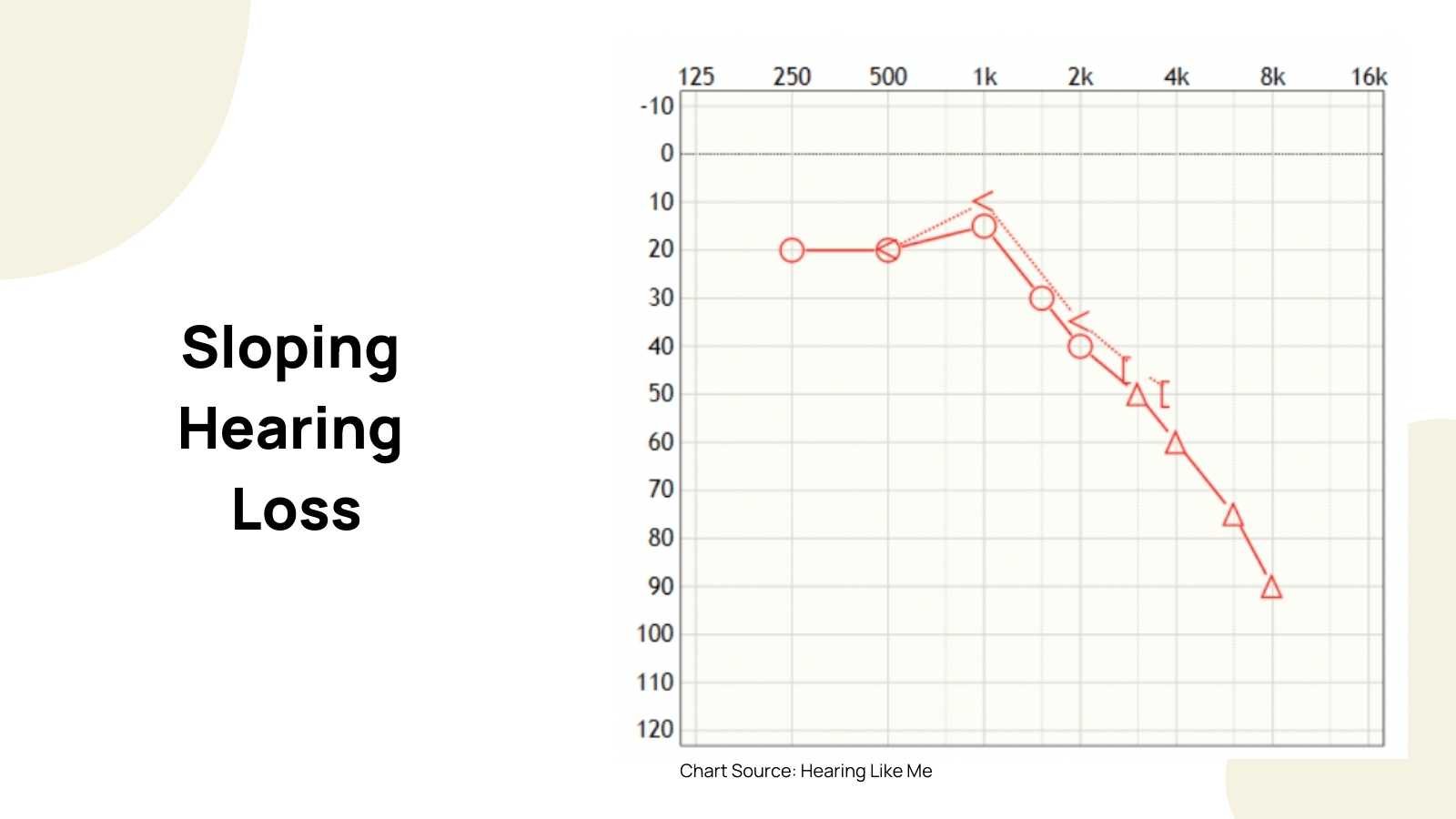
How to Read Your Test
If your test shows mild to moderate hearing loss, you’ll be a candidate for either over-the-counter (OTC) or prescriptive care. However, if your hearing loss is severe or profound, it’s best to seek care at a local clinic. The FDA limits the maximum volume output for OTC hearing aids, making them less suitable for significant hearing loss.
For a deeper dive into understanding your hearing test, watch our full video below.
2. Choose the Right Care Method
Once you understand your hearing loss, the next step is deciding between OTC and prescription hearing aids.
- OTC Hearing Aids:
- Typically cost between $500–$1,000 per pair.
- Offer good sound quality and remote support (when you purchase through Soundly) but require self programming using an app.
- Ideal for budget-conscious users who are comfortable with some tech setup.
- Prescription Hearing Aids:
- Usually cost between $4,000–$7,000 per pair.
- Provide hands-on care from a local professional and adjustments based on real-world feedback.
- Fit a wider range of hearing loss types and offer personalized support.
Consider your budget, level of tech-savviness, and the severity of your hearing loss to decide which care model works best for you.
3. Decide on Hearing Aid Style
Hearing aids come in two primary styles, and choosing the right one depends on your needs and lifestyle.
- Behind-the-Ear:
- Best for sound quality and all-day comfort.
- Typically supports Bluetooth streaming and rechargeable batteries.
- In-the-Ear:
- Ideal for those who wear oxygen or masks and need the space behind their ears clear.
- Generally does not support Bluetooth streaming but offers rechargeability.
Explore the pros and cons of both styles in our video below.
4. Understand Pricing and Insurance
Quality hearing aids can cost anywhere from $100 to $7,000, depending on the care method. While insurance typically doesn’t cover hearing aids, there are some exceptions.
Insurance Coverage:
- Original Medicare: Does not cover hearing aids.
- Medicare Advantage Plans: Coverage varies; call your provider to check.
Typical Costs:
- OTC Hearing Aids: $500–$1,000 per pair.
- Prescription Hearing Aids: $4,000–$7,000 per pair.
Free or Low-Cost Options:
- Veterans Affairs (VA): Eligible veterans can access hearing aids at no cost. Learn more here.
- Medicaid and Federal Programs: Coverage depends on income and location.
- Caption Call: Provides free amplified phones with captioning for those struggling with phone conversations. Learn more here.
Read more about insurance in our guides:
- Hearing aids and Medicare
- Aetna hearing aid health insurance guide
- BCBS hearing aid health insurance guide
- Cigna hearing aid health insurance guide
- UnitedHealthcare hearing aid health insurance guide
Consider Big-Box Stores
For those who don’t mind visiting a local big-box store, Costco and Sam’s Club offer affordable and high-quality hearing aids. Availability depends on your location, but these stores often provide excellent value and reliable technologies.
Check out our full reviews of Costco and Sam’s Club for more details.
Final Thoughts
Shopping for hearing aids as a senior is a lot like shopping for hearing aids at any age: prioritize strong sound quality, all-day comfort, and dependable support.
The products in this guide span a range of prices and care models, offering a solid starting point for your research. If you need additional help, our team is here to assist. Call us at 1-833-SOUNDLY or email us at [email protected].
Not sure where to start? Take our free hearing test here to gain insight into your hearing loss and next steps.
Good luck with your journey to better hearing!





